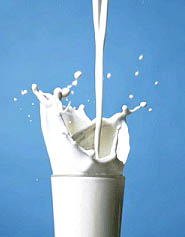Hormones In Milk Can Be Dangerous
By Corydon Ireland (Harvard News Office)
 |
Ganmaa Davaasambuu is a physician (Mongolia), a Ph.D. in environmental health (Japan), a fellow (Radcliffe Institute for Advanced Study), and a working scientist (Harvard School of Public Health). She drew on all those roles during a lunchtime talk to most of her fellow fellows. Ganmaa's topic was lunch-appropriate: the suspected role of cow's milk, cheese, and other dairy products in hormone-dependent cancers. (Those include cancers of the testes, prostate, and breast.)
The link between cancer and dietary hormones - estrogen in particular - has been a source of great concern among scientists, said Ganmaa, but it has not been widely studied or discussed. The potential for risk is large. Natural estrogens are up to 100,000 times more potent than their environmental counterparts, such as the estrogen-like compounds in pesticides. "Among the routes of human exposure to estrogens, we are mostly concerned about cow's milk, which contains considerable amounts of female sex hormones," Ganmaa told her audience. Dairy, she added, accounts for 60 percent to 80 percent of estrogens consumed. Part of the problem seems to be milk from modern dairy farms, where cows are milked about 300 days a year. For much of that time, the cows are pregnant. The later in pregnancy a cow is, the more hormones appear in her milk. Milk from a cow in the late stage of pregnancy contains up to 33 times as much of a signature estrogen compound (estrone sulfate) than milk from a non-pregnant cow. In a study of modern milk in Japan, Ganmaa found that it contained 10 times more progesterone, another hormone, than raw milk from Mongolia.In traditional herding societies like Mongolia, cows are milked for human consumption only five months a year, said Ganmaa, and, if pregnant, only in the early stages. Consequently, levels of hormones in the milk are much lower. "The milk we drink today is quite unlike the milk our ancestors were drinking" without apparent harm for 2,000 years, she said. "The milk we drink today may not be nature's perfect food."
Earlier studies bear out Ganmaa's hypothesis that eating dairy heightens the risk of some cancers.
One study compared diet and cancer rates in 42 counties. It showed that milk and cheese consumption are strongly correlated to the incidence of testicular cancer among men ages 20 to 39. Rates were highest in places like Switzerland and Denmark, where cheese is a national food, and lowest in Algeria and other countries where dairy is not so widely consumed. Cancer rates linked to dairy can change quickly, said Ganmaa. In the past 50 years in Japan, she said, rising rates of dairy consumption are linked with rising death rates from prostate cancer - from near zero per 100,000 five decades ago to 7 per 100,000 today. Butter, meat, eggs, milk, and cheese are implicated in higher rates of hormone-dependent cancers in general, she said. Breast cancer has been linked particularly to consumption of milk and cheese. In another study, rats fed milk show a higher incidence of cancer and develop a higher number of tumors than those who drank water, said Ganmaa. All this begs the question of the health effects of milk on children. About 75 percent of American children under 12 consume dairy every day, but its health effects on prepubescent bodies is not known - "a good rationale for further study," said Ganmaa, who studies bioactive substances in food and reproductive health disorders. She and her Harvard colleagues have already conducted two pilot studies. One compared levels of hormones and growth factors in American milk (whole, whole organic, skim milk, and UHT - ultra-high temperature - milk) to milk from Mongolia. Levels were very low in both American skim and in Mongolian milk.
Another pilot study looked at third-graders in Mongolia. After a month, the hormone levels jumped among the children fed commercial U.S. milk. Long-term studies are needed to see if any of this is important for children's health. "We don't know what the larger implications are," said Ganmaa. (The National Institutes of Health is now reviewing Ganmaa and her team's application to fund a two-year study.) Meanwhile, Ganmaa is investigating 22 years of data from Harvard's Nurses Health Study, looking for a potential link between dairy and endometrial cancer. But she is cautious about the implications of her studies of cancer rates and dairy consumption. For one, said Ganmaa, "milk is a food of great complexity" and contains high levels of beneficial nutrients, including calcium and vitamin D. (Mongolian children, who drink a third less dairy than their American counterparts, have low levels of vitamin D.) "The hormonal effects of milk are very new," said Ganmaa during questions from her Radcliffe audience. Until more research is done, she said, "I'd like to keep our heads low." But steps can be taken now to reduce the amount of hormones in milk, said Ganmaa. Because hormones reside in milk fat, drinking skim milk is one option. Getting calcium from green leafy vegetables is another. Modes of milk production can also change, said Ganmaa. She suggested milking only nonpregnant cows (the Mongolian model), or not milking cows when they are in the later stages of pregnancy, when hormone levels are particularly high. "The dairy industry in the United States is not going to change in any radical way," said artist Shimon Attie, the Mildred Londa Weisman Fellow at Radcliffe - and a former dairyman. But in the meantime, he had a suggestion for the coffee setting at future Radcliffe Fellows luncheons: a pot of nondairy creamer.
-----------------------------------------------------
Mail to : Ahimsa Foundation
www.jainsamaj.org
R020913